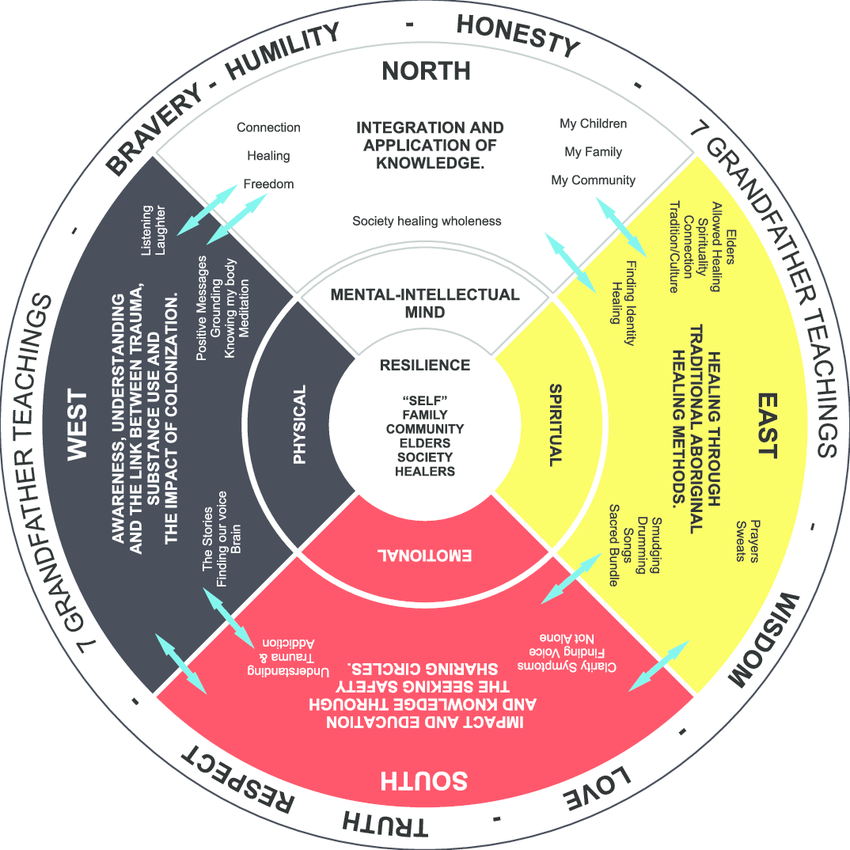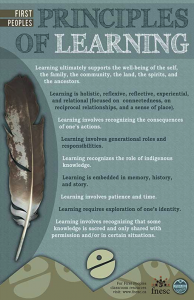
Although I was able to continuously incorporate all First People’s Principles of Learning into my teaching over the past two practicums, there were a few moments that stood out and played an integral part in my students’ learning.
Learning is embedded in memory, history, and story – During our unit on myths, legends, fables, and fairytales, students learned about the importance of stories. We discussed the importance of narrative stories and how they are used for much more than just entertainment purposes. Stories are used to pass down important traditional knowledge though cultures, are used to pass down lessons, and are even used to pass down information such as instructions for family recipes or how to carve a canoe. We explored the idea that stories are also often used to explain the reason for natural or societal phenomena such as earthquakes, floods, wars, or even the placement of buildings or landmarks. Stories reflect a certain culture’s understanding of how things came to be, and are passed down for generations. Students were able to understand that learning can come from many sources, not just textbooks and computers. English language arts is the perfect subject in which to explore the memory, history, and story of many cultures and how it can enhance our learning. We were then able to connect this First People’s Principle of learning to Indigenous legends in order to discover how different Indigenous groups also used story, memory, and history to teach and learn.
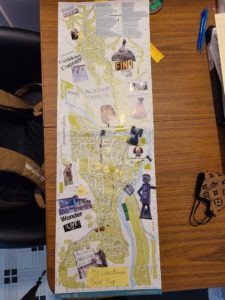
(Sense of Place Map – tells a story about an individual’s experience in Prince George)
Learning is holistic, reflexive, reflective, experiential, and relational (focused on connectedness, on reciprocal relationships, and a sense of place) – There were many parts of both units that drew on the First People’s Principle of Learning. Throughout both units, there was a big focus on connectedness and relationships. Students connected to different cultures through stories, different students/schools within the community, current events, and to each other as human beings. I believe it is extremely important to allow students to create connection within different parts of their life because this is how they build a solid self-identity. We connected our learning to Greek, Norse, Canadian, Indigenous, and European culture through the various types of myths, legends, fables, and fairytales that were studied. This allowed students to think reflexively about their personal life in comparison to the lives depicted within these stories in different cultures. We used “pen pals” as a tool to connect to other students in Prince George which allowed students to create new reciprocal relationships. My Grade 8 students were then able to reflect on their experience of going through elementary school to understand the role they now have as high school students to be role models and mentors to the Grade 2s. Lastly, we were able to connect to our sense of place my keeping up with current events everyday at the end of class. By allowing students to learn about and understand what is going on in other parts of the world and why, it helps them have a clearer understanding of their own physical place within the world. They can start to understand their role in place starting from PGSS, to Prince George, to Canada, and then internationally. The First People’s Principle of learning is perhaps a more complex one but it is an extremely important one to be able to implement into teaching and learning.
Learning involves recognizing the consequences of one’s actions – This First People’s Principle of Learning was mainly explored in our unit about bias, perspective, and opinion in media. We explored the impact that our own (and other people’s) words have in society. We have the power of being connected to millions and millions of people through different social media platforms so it is imperative that we realize that power we have to spread ideas. One post that contains a dangerous bias or unresearched opinion can have a negative ripple affect. Students also explored why and how people develop different biases, perspectives, and opinions and how that can impact people around them. We also spent time exploring fake news and why it can be dangerous. Certain biases, perspectives, and opinions can perpetuate hurtful prejudices such as racism, sexism, ageism, and hate, so it was important that students understood the consequence of information like this being spread. We worked together as a class to come up with ways that our words, actions, and posts on social media can be used to spread good consequences and impact the world in a positive way. This First People’s Principle also draws on reflective and reflexive principles that are extremely important in the development of a strong self-identity.
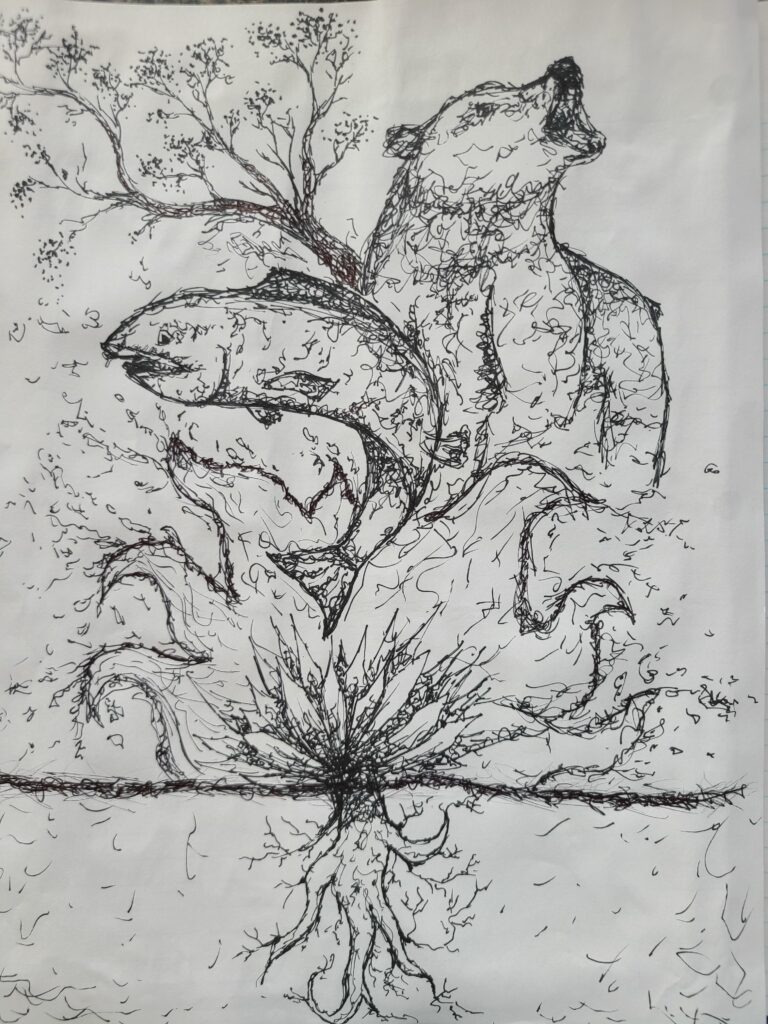
Learning recognizes the role of Indigenous knowledge– One of my goals moving forward throughout my practicums was to incorporate explicit Indigenous content and knowledge in my teaching. While teaching socials studies 9 during practicum 491, I created and taught a unit on local Syilx/Okanagan history and culture. As a class, we explored pre-contact and first contact with Europeans specifically in the Okanagan, the relationships with settlers, and Syilx language (Nsyilxcen), story, and food. We explored the role of Indigenous knowledge through various assignments and activities that were inquiry based and place based. Students explored the Nsyilxcen alphabet, traditional Syilx stories (such as The Four Food Chiefs) and recipes, and maps that showed us the original fur trade route that ran along West Side road. Students were extremely interested and engaged in learning the local knowledge of the Syilx people and it was a very rewarding unit.
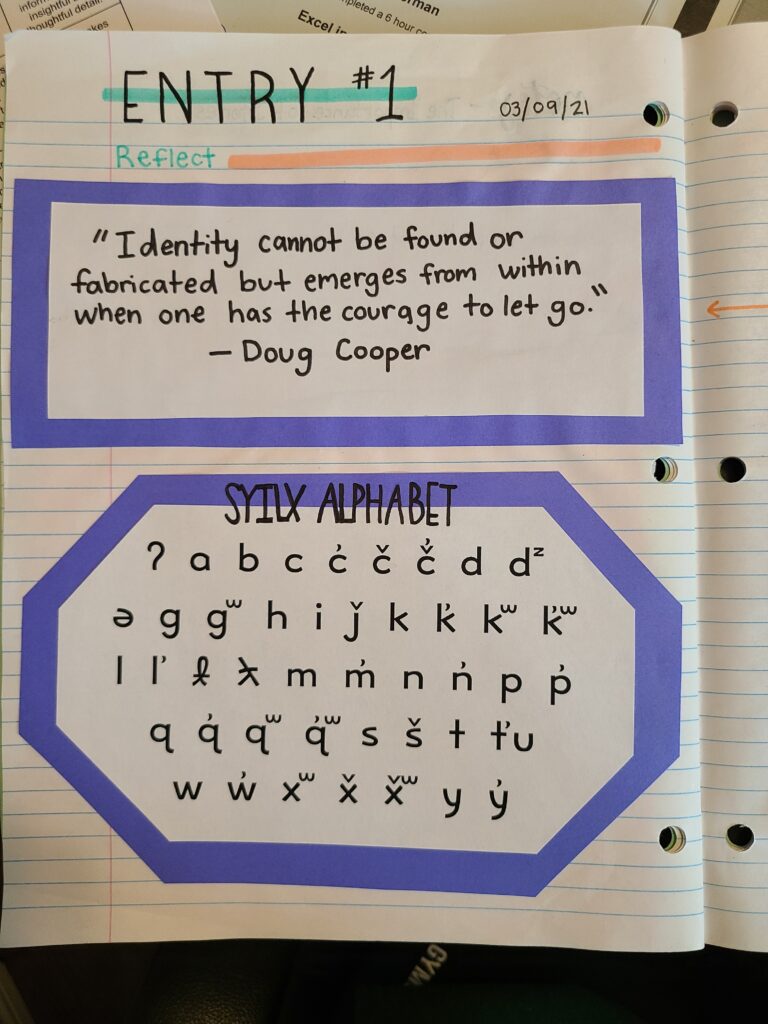
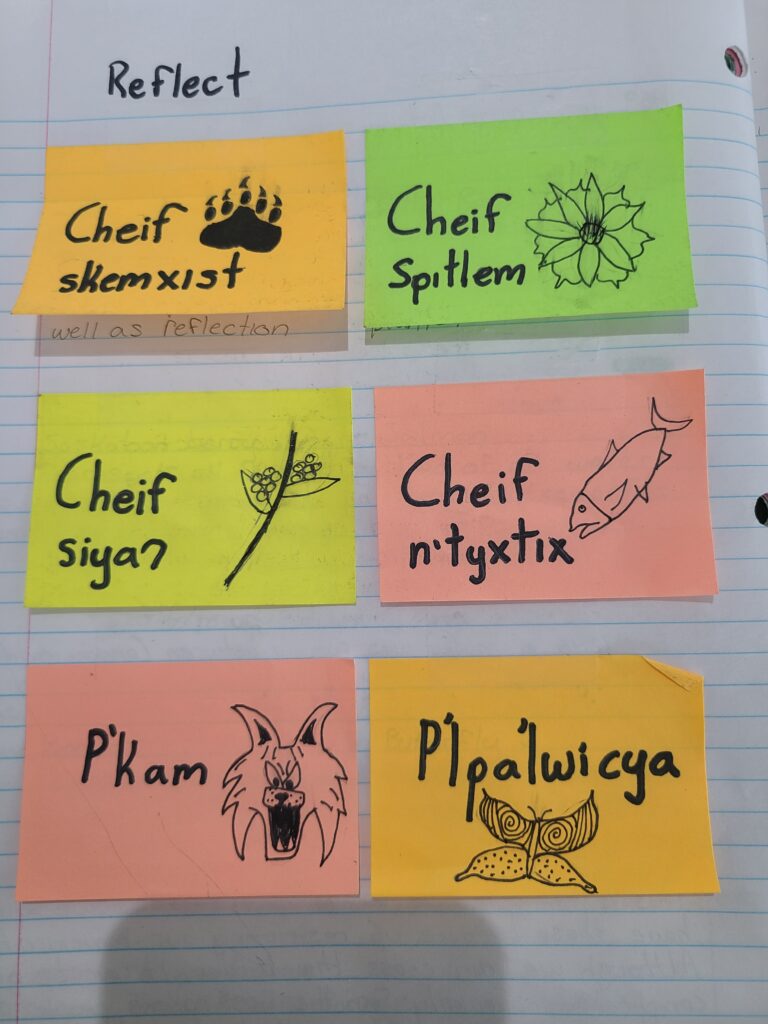
Learning involves generational roles and responsibilities- during the exploration of stories and language in the Syilx/Okanagan unit, as a class, we were able to deeply explore the idea of generational roles and responsibilities in Indigenous culture. By exploring, reading, sharing, and writing stories, we were able to study how traditional information such as recipes, instructions, songs, poetries, stories, etc., are passed down through generations in order to pass on important information to the next generation. We learned that Elders have the responsibility to be the knowledge keepers, passing down information through stories and other oral means when it is time. We also learned about the preservation and revitalization of traditional languages and how many younger people are taking on the responsibility to learning Nsyilxcen in order to pass in down through generations so that it is not lost.
Learning ultimately supports the well-being of the self, the family, the community, the land, the spirits, and the ancestors– I incorporated this standard quite seamlessly into my grade 9 socials study class by exploring family and ancestry. Throughout my unit focused on the Okanagan Syilx peoples, I guided students in the exploration of their own cultures, families, communities, etc., in relation to learning about Syilx culture and society. Students were able to understand the importance of supporting the well-being in different aspects of one’s personal live through exploring the topics of language and story. Through the practice of circular discussions, students shared their own stories of family, heritage, culture, and ancestry. Along with explicitly learning about Syilx history, students inherently learned about how embracing and engaging with one’s own culture can bring health and happiness to the past and present. Students shared family recipes, stories, traditions, music, and even art work, working through understanding the importance of generational teachings not only within their cultures, but within Syilx culture.
Learning involves patience and time – In my grade 12 English class, this First Peoples Principal of Learning was inherently embedded in many of the tasks taken on by the students. One of the most complex and time-consuming units/lessons that the grade 12s did was how to write a properly MLA 8 formatted multi-paragraph essay. Students learned how to set up the proper first page, how to embed running heads, how to use proper in-text citations, and how to create a proper works cited list. I often encouraged students that although learning to properly format an MLA 8 style essay can be exhausting and confusing, practice and patience will ultimately lead to success. My grade 12 students truly rose to the occasion, practicing their MLA 8 style formatting every class which resulted in them being able to write their own 5-paragraph essay with proper in-text citations and a works cited page.
Learning involves the exploration of one’s identity- My grade 11 students explored their identity in my poetry unit when completing the “reconstruction” poem activity. Students were give the same three poems (Lioness Asleep by Babette Deutsch, Caged Bird by Maya Angelou, and Charge of the Light Brigade by Lord Alfred Tennyson) to work with, with the end goal being the creation of a new poem. Students were to cut out individual words from all three poems in order to create a 15-line new poem, identifying topic, theme, and purpose. After the creation of individual poems, students were able to see how their own unique identity impacted the final result of their poem. This was a powerful lesson in exploring identity because even though all students had access to the same poem, the topics, themes, and moods/tones developed were all very different. As a class, we discussed how personal history, experiences, and identity shapes our individual understanding and inspiration of certain topics and subjects.
Learning involves recognizing that some knowledge is sacred and only shared with permissions and/or in certain situations- This First Peoples Principle of Learning was explored with my grade 11’s while reading the book Three Day Road. This book includes the exploration of several different traditional, spiritual healing techniques which are used to heal characters impacted by war and drugs. While the book touches on the most basic information of what these healing techniques are and how they are implemented, as readers we do not get an extremely detailed step-by-step right up of the traditional medicines and healing techniques because the author, Joseph Boyden, is himself practice FPPL #9. I was then able to facilitate a conversation/discussion with students about what it means to only share certain knowledge with permission or in certain situations. Some knowledge and situation is sacred, meaning that it should only be shared in an appropriate situation in the appropriate style. Because the extent of information about Indigenous (Cree) traditional spiritual healing and medicines is expansive, Boyden chooses to share with his audience only enough information to develop the story line and the characters. The rest of the information is not shared because of needed permissions and appropriate situational allowances. The grade 11 students were able to understand that some Indigenous knowledge is sacred and can only be shared by an Elder or in a more intimate setting such as a Potlatch.
